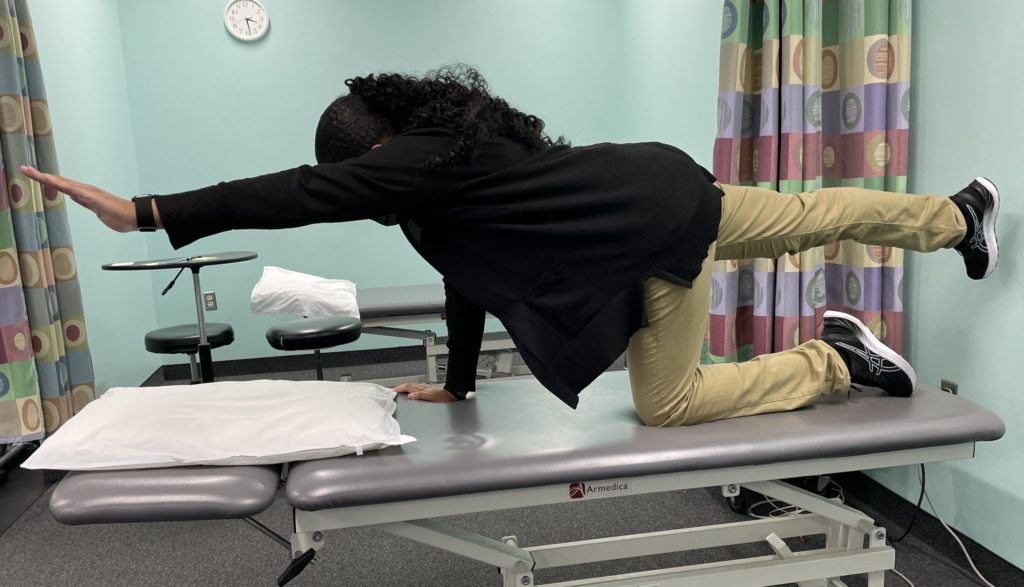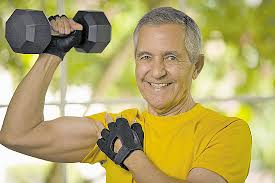This is a great question. Pickleball is gaining popularity and many people are getting into the sport. It attracts people of all ages and fitness levels as it is the type of sport that can be played at different competitive levels. Pickleball is attracting people that are sedentary to get up and start playing. Of course, this is positive in that pickleball is getting people motivated to exercise but it also leads to more injury in people that are not physically equipped to start playing. In addition, pickleball involves going from standing relatively still to quick reactionary motions to get to the ball fast. This has led to a lot of achilles tendon ruptures, ankle sprains, and ankle fractures. If you want to get involved in pickleball, to avoid injury you want to make sure you warm up and stretch after play. In addition to that, you want to work on your overall strength and cardio fitness off the court to help prevent injury on the court.
exercise
Why Core Strength Matters
Have you ever been told to “engage your core”? There is a good reason why. Your core muscles are what provides you spinal stability with exercise and your daily activities. Your core muscles are not just your abdominals. The core includes the transversus abdominis, obliques, pelvic floor, diaphragm, and erector spinae. Strengthening your core muscles helps improve your posture, balance, spinal stability, and decreases your risk of lower back pain. To learn more about your core strength, a physical therapist can provide an assessment and create a tailored exercise program focusing on the areas you need to strengthen.
Benefits of Prehab
Prehab is receiving physical therapy prior to a surgery or before a future physical challenge or sport. The goal is injury prevention and or to prepare your body before a surgery. The physical therapist assesses targeted vulnerable areas and works to improve the deficits found during the evaluation with specific exercises.
Here are some benefits of receiving prehab:
- Injury prevention- Improving strength and stability of weak muscles and joints can prevent common injuries during daily activities and sport.
- Faster recovery- if you have an injury or surgery, the body will be in better condition to handle healing.
- Improved strength, flexibility, and mobility- Improves your overall strength and flexibility, making your body stronger and more mobile with your daily activities.
Do I Need Equipment to Exercise?
When it comes to exercise, many people think they need fancy equipment to achieve their workout goals. However, this is not true. In fact, there are plenty of exercises you can perform without any equipment by just using your body weight. Body weight exercises use your own weight to create resistance. Some examples of body weight exercises are:
Squats
Push-ups
Planks
Lunges
Burpees
You can progress these exercises by increasing the reps, time, and performing different variations. Also, cardio exercises do not require much equipment either. You can run, walk, do a HIIT workout, pilates, yoga, or dance workout in your home. It is always best to vary your workouts to keep you motivated and to build strength, cardio fitness, and muscle endurance.
Who Benefits From Physical Therapy?
Myth: Physical therapy is only for people who are experiencing pain.
Answer: FALSE- Physical therapy can be beneficial to people experiencing a wide variety of conditions. While we do treat a lot of people that have some sort of pain, we can also help those who are not in pain but still limited in their ability to move and get around. Some of these conditions are listed below. Physical therapists are considered “movement experts” and are well equipped to help you reach your movement goals and achieve a higher quality of life.
- Muscle weakness due to aging or chronic neurological conditions – Physical therapists will help develop a program that promotes recruitment and strengthening of weakened muscle areas to help make day to day life both easier and safer.
- Injury prevention – Some patients come to physical therapy because they are prone to injury and want to take the necessary steps to avoid injury prior to starting a new exercise routine.
- Walking abnormalities – Whether due to a genetic abnormality or acquired from a certain illness or injury, physical therapists analyze how you walk and work to improve your walking to be more safe and efficient.
- Decreased balance/stability -A physical therapist helps to decrease your risk of falling by improving your balance and stability through prescribed exercises.
- Deconditioning – This is commonly seen in physical therapy and can be due to a variety of reasons (aging, prolonged hospital stays, chronic injury, etc). A physical therapist will evaluate you and determine and create an exercise plan to improve your muscle strength and endurance.
Can I Exercise While I am Pregnant?
A simple answer is yes, exercising while pregnant can be very beneficial to expecting mothers. There are certain instances, such as high risk pregnancies, where your doctor will likely tell you to avoid non-essential physical activity, but for most pregnant women it is recommended. Below are some guidelines and tips on how to exercise safely while you are expecting.
- Talk with your doctor – make sure you are aware of any restrictions or guidelines your OB-GYN wants you to follow.
- Pre-pregnancy activity levels should equal pregnancy activity levels – being pregnant is not the time to go from couch to 5k if you were sedentary previously. Performing very strenuous exercise such as running a marathon or playing contact sports is not recommended. If you are unsure, always contact your physician.
- Adjust as necessary – as your body changes, your physical activity may also change; be sure to listen to your body and make good/safe choices.
- Avoid exercising on your back – as the baby grows, it can place more pressure on major blood vessels if you exercise on your back for a prolonged period of time.
- Avoid excessive stretching – to help with the birthing process, a woman’s body produces hormones that increase the flexibility of your ligaments. This is something to be aware of while exercising since it puts you at a slightly higher risk of injury.
- Remember to breathe – while it is always important to breathe throughout an exercise, it is particularly important while exercising when expecting. Holding your breath causes increased pressure in your abdominal cavity and can decrease the amount of oxygen being brought to the placenta
Benefits of Physical Therapy for Arthritis
Physical Therapy is a great option for patients with arthritis. Physical Therapists will evaluate your joints that are affected by arthritis to determine your baseline level of motion and strength. Physical Therapy will help to ease your symptoms associated with arthritis by improving your strength and stability through prescribed exercises. With increased muscle strength supporting your joints, it will decrease joint stress and improve overall function. Physical therapist might also recommend certain modalities along with exercises to help decrease your discomfort. Examples of these modalities are heat, massage, and electrical stimulation. The most common joints that are affected by arthritis are the hands, knees, hip, and spine. The good news is all these joints can benefit from physical therapy.
How To Warm-up Before Running
Getting back into running? Trying to figure out where to start? The best way to start your run is with a dynamic warm-up. This allows for increased blood flow to the muscles, aids in raising your core temperature and metabolism, and also provides increased stretch to the muscles you will soon be activating during your run. A dynamic warm-up can reduce your risk for injury and simply prepares the body for activity.
Dynamic Running Warm-up Sample:
- Forward leg swings
- Lateral leg swings
- Walking straight leg kicks
- Walking toe scoops
- Lunges
- High knees / walking knee hugs to chest
- Butt kicks
- Skips
- Side Shuffle
- Grapevine
It’s a Bird. It’s a Dog. It’s a Bird Dog!
The bird dog is a simple exercise that enhances core strength, provides stability, aids in neutralizing spine position, and reduces the onset of low back pain.
The bird dog:
- Improves spinal and core stability by stiffening the musculature and enhancing muscular endurance.
- Improves hip extension by increasing glute strength and aids in differentiating low back extension and hip extension.
- Improves shoulder stability by loading the joint with your body weight to help maintain stability throughout the exercise.
- Improves balance and coordination by engaging in contralateral muscle movements while maintaining proper positioning.
If this exercise is too difficult to perform with contralateral movements – try performing one limb at a time until your balance and stability improves – progress as tolerated!

Focus on Strength Training as You Age
Aging is inevitable; losing your strength and ability to perform daily activities doesn’t have to be. Sarcopenia is a term used to describe the age-related progressive loss of muscle mass and strength. The process begins in your 40s and ramps-up between the ages of 65 and 80. While age-related strength loss is normal, sarcopenia speeds up the loss of muscle mass and can reduce your muscle mass by 8% each decade. Factors such as insulin resistance, obesity, loss of mobility, and inactivity contribute to the progressive loss of muscle mass in older adults and as a result increase the risk for falls and make daily activities difficult to perform.
Sarcopenia is often diagnosed with the following mnemonic:
S – strength (loss of strength)
A – assistive device (use of a device for walking)
R – rising from a chair (difficulty standing from a chair without use of hands)
C – climbing stairs (difficulty with stair climbing)
F – falls (presence of falls in the last year)
Aging might suddenly sound daunting, but it doesn’t have to be as long as you stay moving! Improving your strength and staying active reduces your risk at developing sarcopenia and also improves your quality of life. Strength training alone can improve your ability to complete daily activities, protect your joints from injuries, improve your balance, and reduce your risk for falls. It can also enhance your thinking skills, improve bone density (to reduce risk for osteoporosis), and help manage chronic conditions such as diabetes, heart disease, and depression.
Strength training as you age doesn’t have to be difficult. Research shows that exercising even just 2-3x per week can enhance muscle mass and strength. Ideally, 2-3 sets of 1-2 exercises for each major muscle group should be performed. If the “ideal” situation doesn’t exactly match your lifestyle, try starting small and just get moving! Any physical activity is better than no physical activity, because even small steps lead to big changes. Try walking more often, getting up out of your chair repetitively to build leg strength, lifting small weights, or joining a fitness class at your local facility; make the change to live a longer healthier life!

